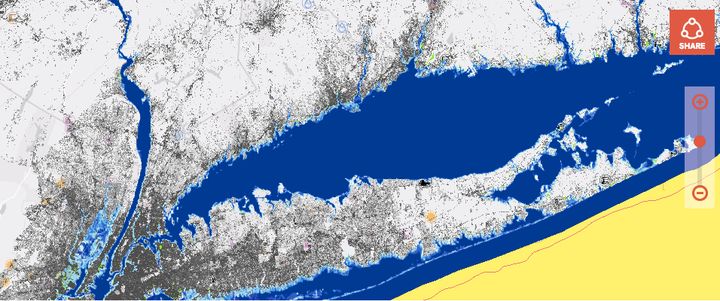
Metropolitan New York, Connecticut, Long Island data visualization.
Of all the keywords we might typically associate with scientists, stylishly tech-savvy might not be at the top of the list. Time to rethink that gross generalization: In a bold reinvention, dense spreadsheets of metrics and predictions are being replaced by stunning data-visualization tools. Astonishing to look at, and instantly actionable: data is shared not by way of musty invitation-only annual conferences but immediately -- via social channels like Twitter, Instagram, and Facebook -- where updates are posted day and night from teams of scientists and their funding agencies on every continent.
Continents including Antarctica: an icy, faraway place with penguins. Breaking news, it’s getting closer. The on-the-ground Project Midas reports a rift in the Larsen C ice shelf that is accelerating the length of five football-fields every day, now measuring two miles wide at some points. In this single development, glaciologists say that Antarctic glaciers will certainly react: as the ice shelf breaks apart, they remove a buttressing force on the glaciers, “effectively removing a cork in front of them,” as one NASA glaciologist explains. Any wedding guest knows what happens when you remove a cork.
When ice melts, it makes water, which flows everywhere and makes a mess. In scientific parlance, this is called “global sea-level rise.” And you can visualize what that looks like via NOAA’s Climate Explorer, which allows you to see impacts in your hometown or in any county in the contiguous US.
Planning a new distribution center? You can compare location vulnerabilities right here.
Curious, I plugged in my hometown in suburban Connecticut and navigated to the “Days with Maximum Above 95°F.” I can’t remember much blistering heat as a kid, and the graph confirms my memory: there’s virtually zero incidence of such high temps until about twenty years ago – with likelihood burgeoning through the end of the century, when we’ll be sizzling off the charts. In metropolitan New York City, as elsewhere, these beastly hot days will clearly, steadily increase, with broad health implications for people with asthma, for example, or pregnant women, or people who must work outside in the sweltering heat. To say nothing of onerous loads on cooling capacity. Or the drought that might accompany these conditions.
Adaptation is the new buzzword, because we’ve already lost our opportunity to stop this.

Published time: 6 Jan, 2017 19:14
It’s not by chance that the New York Times’ brand-new, inaugural Climate Editor spent the past 15 years on the Times graphics team and most recently as the visual editor for “enterprise projects on climate.” Now you can visit NYTimes.com and see a time-lapse map visualization of the Larsen C news, incorporating imagery from Sentinel-1 monitoring satellites. The folks at Kia’s ad agency have picked up on this, positioning Melissa McCarthy atop the widening gap in their winning Superbowl ad.
As the gob-smacking repercussions to our global fossil-fuel habit continue to reveal, a wonderful public awareness is happening. All of us can share news in our networks of family, friends, and co-workers. We can push for rapid positive change in our organizations and communities. Those of us who’ve been on this beat for a while will find there’s good company: we can anticipate that others who may have been quiet will now be activated.
This week a group of venerable elder Republican statesmen announced their plan for a carbon tax and dividend. “The Conservative Case for Carbon Dividends” is a comprehensive model, an “insurance policy,” as they say, that will reduce exposure to risk if even the least bad of the bad predictions occur. Simply put, the $40/ton tax will discourage carbon emissions, and the proposal sends revenues back to the American taxpayers, with an average family of four receiving $2,000 annually.
Interested? A snappy memo to the new President and his team in the current issue of Scientific American underscores the win-win economics of such a plan. Three main points:
1) Urgency: “Climate change is not like other issues that can be postponed from one year to the next.” We need to act Now.
2) Think Global: “Because emissions anywhere result in climate change everywhere, we are part of a community of nations that must work together to tackle this global problem.” Climate Change won’t be put behind a Wall.
3) America the Great: “The clean energy revolution is well under way. The rest of the world is no longer debating climate change; it is moving on with a rapid transition to carbon-free energy. Do we want to be left behind in the great economic revolution of the 21st century? Or do we want to compete in the clean energy race, improving our international competitiveness and making our nation even greater? Do we want to buy solar panels and wind turbines from China, or do we want to manufacture and sell them to China and everywhere else?”
If dinosaurs had access to scientists and a Facebook account, could they have staved off their own extinction?
Let’s not be dodos, people. Let’s move on from the fossils.
Consider the options, act on the best ones. Invest energetically in smart solutions. Push for improvements from our leaders in business, politics, and wherever they are. Let’s use the best of our convenient, modern communications channels to share the facts, celebrate success stories, build support, and do whatever we can in our various spheres of influence to take this low-carbon transition groundswell up a notch or two. And let’s do it Now.
